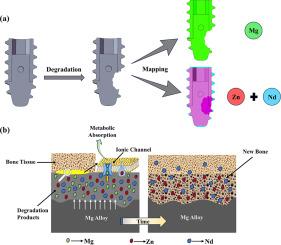镁合金降解产物在骨组织中的代谢行为
IF 13.8
1区 材料科学
Q1 METALLURGY & METALLURGICAL ENGINEERING
引用次数: 0
摘要
镁合金具有良好的力学性能、生物相容性和生物可降解性,是一种潜在的革命性骨植入材料。虽然镁合金的体内和体外降解行为已经被广泛探索,但对不同元素降解产物的体内代谢行为的研究很少。本研究采用Mg-2 wt. % Zn-0.5 wt. % Y-1 wt. % Nd-0.5 wt. % Zr (ZE21C)合金制备缝合锚钉,植入大鼠胫骨近端髌骨韧带。通过SEM、EDS、micro-XRF和western blotting分析降解产物中镁、锌和钕在体内的代谢行为。这些结果表明Mg被快速代谢和吸收。然而,锌和钕的代谢速率较慢,并以降解产物的形式积累。这主要是因为降解产生的微环境通过影响阳离子渗透通道蛋白的表达来抑制代谢。本研究分析了镁合金的降解和代谢行为,为Zn作为合金元素的生物应用提供参考。本文章由计算机程序翻译,如有差异,请以英文原文为准。

Metabolic behavior of the degradation products of magnesium alloys in bone tissue
Magnesium alloys are potentially revolutionary bone implant materials owing to their favorable mechanical properties, biocompatibility, and biodegradability. Although the in vivo and in vitro degradation behavior of Mg alloys have been extensively explored, only a few in vivo studies on the metabolic behavior of the degradation products of different elements are available. In this study, a Mg-2 wt. % Zn-0.5 wt. % Y-1 wt. % Nd-0.5 wt. % Zr (ZE21C) alloy was used to prepare suture anchors, which were implanted into the patellar ligament proximal tibia of rats. The metabolic behavior of magnesium, zinc, and neodymium in the degradation products in vivo was analyzed through SEM, EDS, micro-XRF, and western blotting. These results indicate that Mg was rapidly metabolized and absorbed. However, Zn and Nd exhibited slow metabolic rates and accumulated as degradation products. This is mainly because the microenvironment generated by degradation inhibits metabolism by affecting the expression of cation-permeable channel proteins. This study analyzed the degradation and metabolic behavior of Mg alloys and provides a reference for the biological application of Zn as an alloying element.
求助全文
通过发布文献求助,成功后即可免费获取论文全文。
去求助
来源期刊

Journal of Magnesium and Alloys
Engineering-Mechanics of Materials
CiteScore
20.20
自引率
14.80%
发文量
52
审稿时长
59 days
期刊介绍:
The Journal of Magnesium and Alloys serves as a global platform for both theoretical and experimental studies in magnesium science and engineering. It welcomes submissions investigating various scientific and engineering factors impacting the metallurgy, processing, microstructure, properties, and applications of magnesium and alloys. The journal covers all aspects of magnesium and alloy research, including raw materials, alloy casting, extrusion and deformation, corrosion and surface treatment, joining and machining, simulation and modeling, microstructure evolution and mechanical properties, new alloy development, magnesium-based composites, bio-materials and energy materials, applications, and recycling.
 求助内容:
求助内容: 应助结果提醒方式:
应助结果提醒方式:


